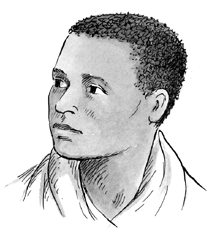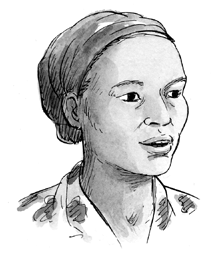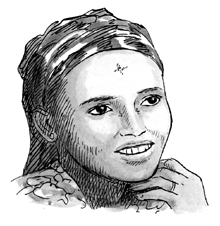
|
|
A Walk to Beautiful
|

|
|
Program Overview and Discussion Guide
|

|
Note: This program offers a dramatic look at the lives of
women in Ethiopia, with stories told in their own voices. The
program contains sensitive material about teen pregnancy,
stillbirths, incontinence, and sexual coercion that—while
integral to this powerful story—may be upsetting for some
students. Please preview the program to determine its
appropriateness for your students.
NOVA follows three Ethiopian women on their journey to find a cure
for injuries they sustained during childbirth that have left them
incontinent and shunned by their husbands and the communities in
which they live.
The program:
-
introduces 25-year-old Ayehu, who developed obstetric fistula
after a weeklong labor resulted in a stillbirth.
-
explains what obstetric fistula is—a condition that occurs
during childbirth, in which tissue between the vagina and the
bladder (and/or rectum) dies, leaving a hole and leading to
incontinence.
-
notes that fistula can happen to young women who grow up without
proper nourishment—or whose limited calories are spent in
manual labor—so that they are physically too small to have
a healthy pregnancy and are unable to deliver a full-term baby.
-
raises the subject of arranged marriages and child brides.
-
follows the story of three women—Ayehu, Almaz, and
Wubete—as they journey from their remote villages to the
Addis Ababa Fistula Hospital to seek a cure for their injuries.
relates how each woman came to be at the hospital. -
tracks the women's progress at the hospital as each undergoes
treatments for her condition, and reports on each woman's
outcome.
-
notes that fistula, while 100 percent preventable, is a silent
epidemic because it primarily affects poor girls and women in
developing countries.
Taping Rights
Can be used up to one year after program is recorded off the air.
Background
Obstetric fistula is a severe medical
condition in which, during childbirth, a fistula (or hole) develops
between a woman's bladder and vagina and/or rectum and vagina. If a
woman with prolonged obstructed labor does not receive medical care
in time, the blood supply to the tissues of the vagina and the
bladder (and/or rectum) is cut off. The tissue dies and rots away,
leaving a fistula, which can result in permanent incontinence of
urine (and/or feces). Left untreated, fistula can also lead to
chronic medical problems, including ulcerations, kidney disease, and
nerve damage in the legs. In addition, women with obstetric fistula
have a high rate of infertility. Obstructed labor occurs in about 5
percent of all deliveries worldwide and happens when the baby cannot
pass through the birth canal without medical assistance, either
because the baby is too large or the birth canal is too narrow.
An obstetric fistula can be closed with surgery. When a skilled
surgeon performs the surgery and the patient receives competent
after-care treatment, she has a good chance of returning to a normal
life with full control of her body functions. The Addis Ababa
Fistula Hospital in Ethiopia has a 93 percent success rate with
surgeries performed to close the fistula. However, because the
structures that enable urinary control can also be damaged during
obstructed labor, 10 to 30 percent of women whose fistulas have been
successfully closed still cannot control their urination.
Obstetric fistula occurs primarily among impoverished women in
developing countries, particularly those living far from medical
services. Although no one knows for sure how many new fistulas occur
each year, it is generally estimated that 50,000 to 100,000 women
develop obstetric fistulas annually and that more than 2 million
women currently live with fistula injuries. The majority of those
suffering from obstetric fistula live in Africa and parts of Asia.
The same women face additional health risks during pregnancy or
childbirth. Each year more than half a million women die due to
pregnancy- and childbirth-related causes; in addition, approximately
10 million women experience short- or long-term injuries, including
obstetric fistula. Although the world's first fistula hospital, in
the late 1800s, stood at the present site of the Waldorf Astoria
Hotel in New York, obstetric fistula has been essentially eliminated
in the United States.
Currently, the global capacity for treating women living with
fistula is estimated at 10,000 women per year. The average cost of
fistula treatment at the Addis Ababa Fistula
Hospital—including surgery and postoperative care—is
$450, well beyond the reach of most women with the condition. Thus,
many patients receive the treatment free of charge through funding
by organizations and private donors.
Along with the medical issues, women living with fistula experience
a number of social stigmas as well. Poverty, early marriage, and
lack of education place women at a severe disadvantage and are
obstacles to their ability to advocate for their own health and
well-being. Many women who develop fistulas are abandoned by their
husbands and close family members, ostracized by their communities,
and forced to live an isolated existence because of odor,
perceptions of uncleanliness, mistaken assumptions that sexually
transmitted infections are present, and, in many cases, the
inability to have children. Women living with fistula are often
blamed by others for their condition under the misconception that
the fistula occurred as a punishment for some wrongdoing. As a
result, in addition to medical care, many women need emotional
support to help them return to their communities.
Obstetric fistulas, other childbirth-related conditions and
injuries, and maternal death can all be prevented by ensuring that
every woman has a skilled health provider with her at delivery as
well as access to emergency obstetrical care in the case of
complications. Prenatal care visits are important to help women plan
for the birth. Family planning, including spacing of at least two
years between births, also helps prevent the occurrence of fistula.
In addition, efforts to promote the education of young women and to
discourage early marriage could make a difference.
However, many countries have severe shortages in the number of
doctors, nurses, and midwives who can assist women during
childbirth. Availability of and access to medical facilities that
have the trained staff and specialized surgical equipment needed for
cesarean births are very limited in certain parts of the world, and
many women who suffer from obstetric fistula live in remote rural
areas and lack the means for transport to facilities where they
could receive help.
A host of factors influence a woman's ability—or her
decision—to seek emergency care. A primary obstacle is lack of
awareness about potential complications during delivery and what to
do should complications arise. Other factors that come into play
include a general fear and mistrust of hospitals and healthcare
workers, a lack of facilities and trained staff nearby, an inability
to afford health care, and cultural preferences for home delivery.
Guidelines for Facilitating a Discussion
This guide was developed to provide a framework for engaging
students in a discussion of the issues surrounding obstetric
fistula. Below are some suggestions to help you facilitate an open
and engaging discussion, followed by some activities you can do with
students to further explore the program's topics.
-
If possible, preview the program in its entirety. This will
serve to ground you in the content and give you time to process
your own ideas before you lead a discussion.
-
Review both the Background section and the Discussion Questions
beforehand. Consult the Links and Articles section for
additional information.
-
The Discussion Questions have been grouped into three
categories: general starter questions, which probe for viewers'
thoughts and impressions of the film; fistula questions, which
focus on the medical condition; and social, cultural, and policy
issue questions, which ask viewers to discuss some of the more
sensitive and/or controversial aspects of the film.
-
Prior to students' viewing of the film, consider conducting a
brief discussion to introduce some of the themes the program
covers. Review societal expectations for adolescence, marriage,
gender roles, and life opportunities. Encourage students to take
notes during the film for later discussion.
-
Keep in mind that the program features issues that may be
volatile. Discussions could include such topics as childbirth
injuries, child marriage, sexual coercion and/or rape, gender
roles, discrimination, and women's rights. When the subject
involves cultural and social differences, it is important to be
sensitive to differing viewpoints.
Discussion Questions
General Starter Questions
To get the discussion started, consider posing one or more general
questions about the film, such as:
-
What is your initial impression of the film? Did anything in
this film surprise you? If so, what? Why was it surprising?
-
If a friend were to ask you what this film is about, what would
you say?
-
If you could ask anyone in the film a single question, who would
you choose, and what would you ask?
-
Why do you think the filmmakers made this program? What were
they hoping to accomplish?
-
Why do you suppose the film is titled "A Walk to Beautiful"?
-
What insights or inspiration did you gain from this film? What
did you learn about the film's subjects and/or about yourself?
Fistula Questions
-
What is obstetric fistula? How and why does it occur?
-
What are some of the physical consequences of fistula? What are
some of the psychosocial consequences?
-
What regions of the world have the highest rates of fistula? How
widespread is the problem? Why is this so?
-
Can obstetric fistula be treated? If so, how? Are there any
risks associated with the treatment?
How can obstetric fistulas be prevented?
Social, Cultural, and Policy Issue Questions
-
What are the characteristics of the lives of the women profiled
in the film? What do the women have in common? How are they
different?
-
In addition to the physical ramifications, how has having
fistula affected Ayehu and the other women who come to the
hospital for help?
-
Both Ayehu and Wubete express that death would be preferable to
living with fistula. Why do you think they might feel this way?
-
Compare attitudes toward marriage, childbearing, and gender
roles that you see in the film with attitudes toward marriage,
childbearing, and gender roles in the United States. What are
some of the attitudes you see in the program regarding women?
What are some similarities and differences between the attitudes
that appear in the program and those in the United States? In
your view, what accounts for the similarities and differences?
-
What are some of the factors that contribute to the
disproportionate number of fistula patients among young, poor,
often illiterate women in remote areas?
-
Dr. Catherine Hamlin, who opened the Addis Ababa Fistula
Hospital in 1974, states that "These women [fistula patients]
are not welcome in a general hospital." Based on what you've
seen in the film, for what reasons might regular hospitals in
Ethiopia and other countries turn away fistula patients?
-
How do the hospitals and health-care workers featured in the
film seek to help fistula patients? Are these strategies
sensitive to community traditions? Should they be?
-
Hospital staff members try to encourage the women in their care
to talk about what happened to them. What is the value of having
people listen to their stories? What is the power of serving as
a witness to the stories that the hospital patients tell?
-
During most of the 20th century, obstetric fistula was largely
missing from the international global health agenda. What are
some possible reasons why this problem was ignored? How can
increased awareness help fistula patients? What more needs to be
done?
Activities
-
The efforts of organizations to address the problems relating to
obstetric fistula focus on three main areas: treatment,
prevention, and rehabilitation. Separate the class into groups
to research what is being done in each of these areas. After
students have completed their research, have each group present
its findings. Which area seems to be having the most success?
Why? Which area seems to be the weakest? Why? What else might be
done to help eliminate obstetric fistula?
-
There are many African and Asian countries that need resources
to help identify, treat, and follow up with women who live with
fistula. One way to increase awareness of the problem and
generate funding for fistula prevention and treatment services
is to develop an advocacy campaign, which may involve components
such as letters, print materials, and/or videos. Organize
students into groups and have each group create its own
campaign, using the following questions as guidelines:
-
What type of campaign do you want to develop? (e.g.,
informational, fundraising, awareness)
-
Who will be your audience? (e.g., the general public,
politicians, health providers, press)
-
What information will you include about obstetric fistula?
-
What materials will you need? How will your materials reach
your intended audience?
How will you fund your campaign?
-
The following is a list* of some of the problems faced by
organizations and healthcare providers trying to treat and
prevent fistula. Display the list and work with students as a
class to determine if these problems would be considered legal,
political, clinical, psychosocial, and/or cultural. What are
some possible actions that could be taken in each case?
-
insufficient medical facilities and/or trained providers
insufficient human resources insufficient financial resources -
insufficient political support for maternal health issues
-
lack of access to quality care, including lack of transport
to facilities that can provide emergency obstetric care
-
affected population is unaware of the extent of the problem
(i.e., women affected by fistula don't realize it is a
common condition)
-
affected population is unaware of treatment possibilities
-
affected population needs to be reintegrated into the
community
-
insufficient and/or inconsistently applied laws in cases of
rape and sexual violence
gender inequalities malnutrition lack of general education childhood marriage and teen pregnancy -
conflicting health priorities, such as malaria, HIV/AIDS,
and child health
* List drawn in part from "Traumatic Gynecologic Fistula: A
Consequence of Sexual Violence in Conflict Settings," published
May 2006.
-
While the effects of fistula can be devastating for women living
with the condition, obstetric fistula is only one of many
maternal health issues that women in developing countries face
worldwide. In 2000, the United Nations established eight
measurable goals designed to combat poverty, hunger, disease,
illiteracy, environmental degradation, and discrimination
against women. Give students the following list of these goals,
now known as the Millennium Development Goals. As a class,
discuss the goals and consider what role, if any, each plays in
ensuring maternal health:
- Eradicate extreme poverty and hunger
- Achieve universal primary education
- Promote gender equity and empower women
- Reduce child mortality
- Improve maternal health
- Combat HIV/AIDS, malaria, and other diseases
- Ensure environmental sustainability
- Create a global partnership for development
Organize students into eight groups and assign each group one of
the goals. Have each group use the The Millennium Development
Goals Report 2007 at
www.un.org/millenniumgoals/pdf/mdg2007.pdf
and the Millennium Development Goals: 2007 Progress Chart at
www.un.org/millenniumgoals/docs/MDG_Report_2007_Progress_Chart_en.pdf
to analyze the progress being made on its goal and report to the
class. Then, as a class, analyze which goals have shown the most
and least gains, and why that might be.
Again as a class, brainstorm possible action steps that group
members could take right now in the effort to achieve some of
the Millennium goals that have made the least progress. Discuss
students' suggestions. What kinds of steps make the most sense
when the task is to combat problems that are geographically far
away?
Links & Articles
Web Sites
Campaign to End Fistula
www.endfistula.org
Provides information about the global Campaign to End Fistula, along
with information on efforts for treatment, prevention, and
rehabilitation. Includes video segments that examine the effects of
fistula in greater detail.
Fistula Foundation
www.fistulafoundation.org
Features information about fistula and efforts to treat and prevent
the problem.
The Worldwide Fistula Fund
worldwidefistulafund.org
Describes obstetric fistula and lists ways of preventing the
condition.
Articles
Faces of Dignity: Seven Stories of Girls & Women with Fistula
www.womensdignity.org/Face_of_Dignity.pdf
Examines seven personal stories of women and girls with fistula.
Living Testimony: Obstetric Fistula and Inequities in Maternal
Health
www.unfpa.org/upload/lib_pub_file/746_filename_living_fistula_eng.pdf
Highlights social, cultural, and economic dimensions of obstetric
fistula by presenting key findings of country-level needs
assessments conducted in twenty-nine countries in Africa, Asia, and
the Arab States from 2003 to 2006.
|


Ayehu
|

Almaz
|

Wubete
|
|
Anatomy of Childbirth
Follow the stages of normal labor and delivery, and learn
about potential problems that can arise—as well as
treatments used to respond to them—in the interactive
activity at
pbs.org/nova/beautiful/birth.html.
|
|
Two Worlds
To help the class further explore disparities in the realm of
childbearing and maternal health care between women in rich
and poor countries, have students answer the eleven questions
in the online Two Worlds quiz at
pbs.org/nova/beautiful/women.html
You can do the quiz as a class, have students team up in
pairs, or have them work on the questions individually. The
quiz is also available in a printable format with an Answer
Key. Once students have finished the quiz, discuss their
answers as a class. How many students got more than half the
answers right? Which answers did students find most
surprising?
|
|
